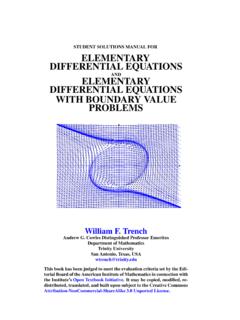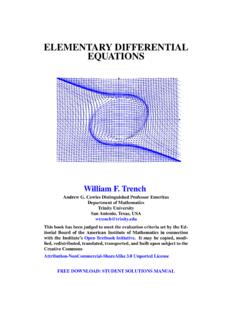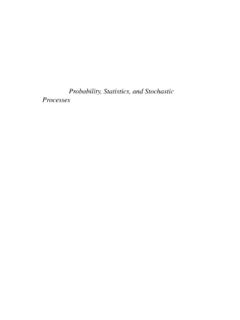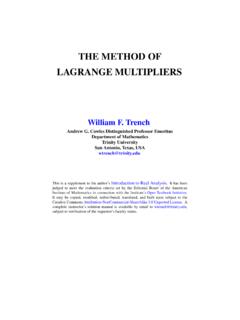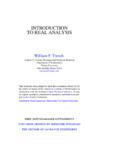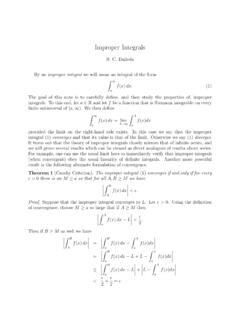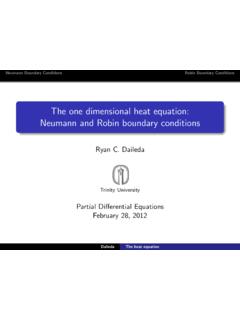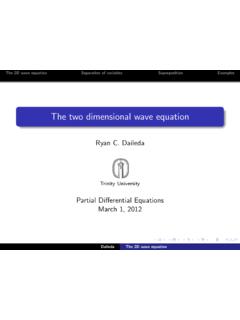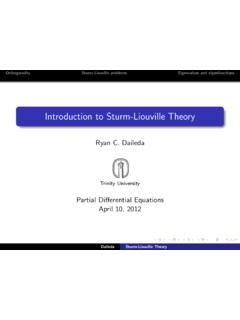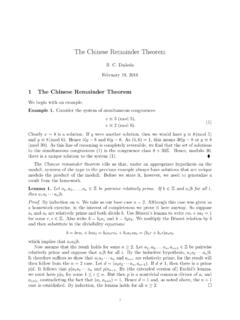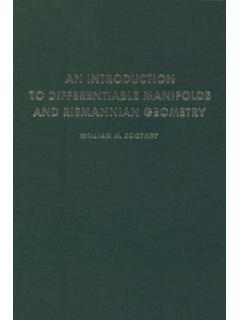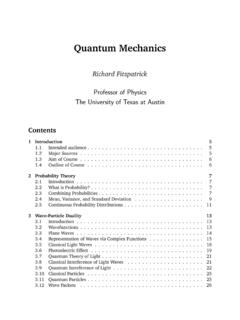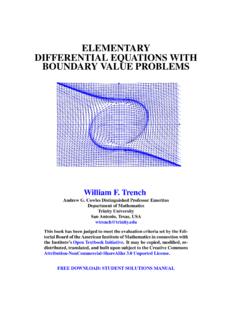Transcription of ELEMENTARY DIFFERENTIAL EQUATIONS
1 ELEMENTARY DIFFERENTIAL . EQUATIONS . William F. Trench Andrew G. Cowles Distinguished Professor Emeritus Department of Mathematics Trinity University San Antonio, Texas, USA. This book has been judged to meet the evaluation criteria set by the Edi- torial Board of the American Institute of Mathematics in connection with the Institute's Open Textbook Initiative. It may be copied, modified, re- distributed, translated, and built upon subject to the Creative Commons Attribution-NonCommercial-ShareAlike Unported License.
2 FREE DOWNLOAD: STUDENT SOLUTIONS MANUAL. Free Edition (December 2013). This book was published previously by Brooks/Cole Thomson Learning, 2001. This free edition is made available in the hope that it will be useful as a textbook or reference. Reproduction is permitted for any valid noncommercial educational, mathematical, or scientific purpose. However, charges for profit beyond reasonable printing costs are prohibited. TO BEVERLY. Contents Chapter 1 Introduction 1. Applications Leading to DIFFERENTIAL EQUATIONS First Order EQUATIONS 5.
3 Direction Fields for First Order EQUATIONS 16. Chapter 2 First Order EQUATIONS 30. Linear First Order EQUATIONS 30. Separable EQUATIONS 45. Existence and Uniqueness of Solutions of Nonlinear EQUATIONS 55. Transformation of Nonlinear EQUATIONS into Separable EQUATIONS 63. Exact EQUATIONS 73. Integrating Factors 83. Chapter 3 Numerical Methods Euler's Method 96. The Improved Euler Method and Related Methods 109. The Runge-Kutta Method 119. Chapter 4 Applications of First Order Equations1em 130. Growth and Decay 130.
4 Cooling and Mixing 140. ELEMENTARY Mechanics 151. Autonomous Second Order EQUATIONS 162. Applications to Curves 179. Chapter 5 Linear Second Order EQUATIONS Homogeneous Linear EQUATIONS 194. Constant Coefficient Homogeneous EQUATIONS 210. Nonhomgeneous Linear EQUATIONS 221. The Method of Undetermined Coefficients I 229. iv The Method of Undetermined Coefficients II 238. Reduction of Order 248. Variation of Parameters 255. Chapter 6 Applcations of Linear Second Order EQUATIONS 268. Spring Problems I 268.
5 Spring Problems II 279. The RLC Circuit 291. Motion Under a Central Force 297. Chapter 7 Series Solutions of Linear Second Order EQUATIONS Review of Power Series 307. Series Solutions Near an Ordinary Point I 320. Series Solutions Near an Ordinary Point II 335. Regular Singular Points Euler EQUATIONS 343. The Method of Frobenius I 348. The Method of Frobenius II 365. The Method of Frobenius III 379. Chapter 8 Laplace Transforms Introduction to the Laplace Transform 394. The Inverse Laplace Transform 406.
6 Solution of Initial Value Problems 414. The Unit Step Function 421. Constant Coefficient EQUATIONS with Piecewise Continuous Forcing Functions 431. Convolution 441. Constant Cofficient EQUATIONS with Impulses 453. A Brief Table of Laplace Transforms Chapter 9 Linear Higher Order EQUATIONS Introduction to Linear Higher Order EQUATIONS 466. Higher Order Constant Coefficient Homogeneous EQUATIONS 476. Undetermined Coefficients for Higher Order EQUATIONS 488. Variation of Parameters for Higher Order EQUATIONS 498.
7 Chapter 10 Linear Systems of DIFFERENTIAL EQUATIONS Introduction to Systems of DIFFERENTIAL EQUATIONS 508. Linear Systems of DIFFERENTIAL EQUATIONS 516. Basic Theory of Homogeneous Linear Systems 522. Constant Coefficient Homogeneous Systems I 530. vi Contents Constant Coefficient Homogeneous Systems II 543. Constant Coefficient Homogeneous Systems II 557. Variation of Parameters for Nonhomogeneous Linear Systems 569. Preface ELEMENTARY DIFFERENTIAL EQUATIONS with Boundary Value Problems is written for students in science, en- gineering, and mathematics who have completed calculus through partial differentiation.
8 If your syllabus includes Chapter 10 (Linear Systems of DIFFERENTIAL EQUATIONS ), your students should have some prepa- ration in linear algebra. In writing this book I have been guided by the these principles: An ELEMENTARY text should be written so the student can read it with comprehension without too much pain. I have tried to put myself in the student's place, and have chosen to err on the side of too much detail rather than not enough. An ELEMENTARY text can't be better than its exercises. This text includes 1695 numbered exercises, many with several parts.
9 They range in difficulty from routine to very challenging. An ELEMENTARY text should be written in an informal but mathematically accurate way, illustrated by appropriate graphics. I have tried to formulate mathematical concepts succinctly in language that students can understand. I have minimized the number of explicitly stated theorems and def- initions, preferring to deal with concepts in a more conversational way, copiously illustrated by 250 completely worked out examples. Where appropriate, concepts and results are depicted in 144.
10 Figures. Although I believe that the computer is an immensely valuable tool for learning, doing, and writing mathematics, the selection and treatment of topics in this text reflects my pedagogical orientation along traditional lines. However, I have incorporated what I believe to be the best use of modern technology, so you can select the level of technology that you want to include in your course. The text includes 336. exercises identified by the symbols C and C/G that call for graphics or computation and graphics.
